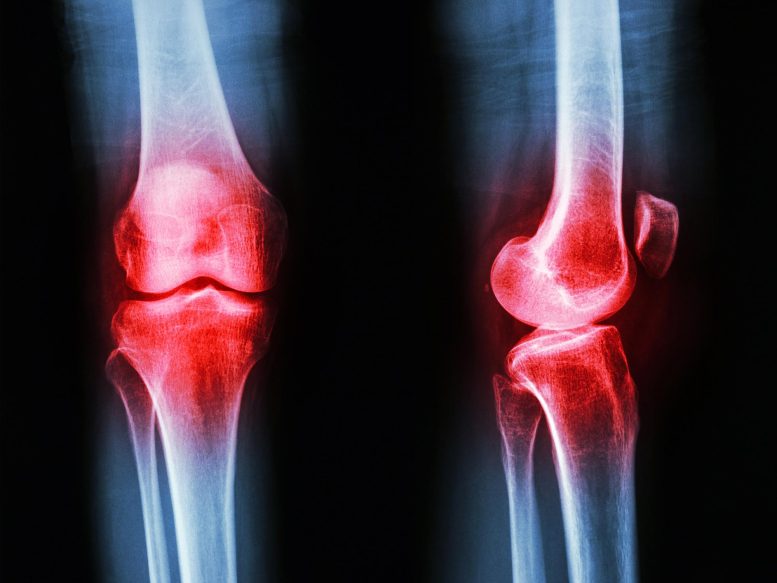
A groundbreaking study from the University of Adelaide reveals that osteoarthritis may be reversible through a new treatment targeting Gremlin 1 gene-marked stem cells. With promising results from stimulating these cells in mice, and human trials in progress following a successful five-year study, this research challenges the traditional view of osteoarthritis and suggests a potential paradigm shift in its treatment.
Existing therapies for osteoarthritis focus on symptom relief instead of tackling the root cause of the disease. However, recent research conducted by the University of Adelaide has shown the condition may be treatable and reversible.
Osteoarthritis involves the breakdown of cartilage and surrounding joint tissues and is the most common form of arthritis in Australia, with 20% of individuals over 45 years old suffering from it.
It is a long-term and progressive condition that affects people’s mobility and has historically had no cure. Its treatment cost the Australian health system an estimated $3.9 billion in 2019-20.
Groundbreaking Research on Stem Cells
Often described as a ‘wear and tear’ condition, factors such as aging, obesity, injury, and family history contribute to the progression of osteoarthritis.
University of Adelaide researchers discovered a novel population of stem cells – marked by the Gremlin 1 gene – responsible for the progression of osteoarthritis.
Treatment with fibroblast growth factor 18 (FGF18) stimulated the proliferation of Gremlin 1 cells in joint cartilage in mice, leading to significant recovery of cartilage thickness and reduced osteoarthritis.
Gremlin 1 cells present opportunities for cartilage regeneration and their discovery will have relevance to other forms of cartilage injury and disease, which are notoriously challenging to repair and treat.
It challenges the categorization of osteoarthritis as wear and tear.
A Paradigm Shift in Osteoarthritis Treatment
“The findings of our study reimagine osteoarthritis not as a ‘wear and tear’ condition but as an active, and pharmaceutically reversible loss of critical articular cartilage stem cells,” said the University of Adelaide’s Dr Jia Ng from the Adelaide Medical School, who co-led the study.
“With this new information, we are now able to explore pharmaceutical options to directly target the stem cell population that is responsible for the development of articular cartilage and progression of osteoarthritis.”
While Dr Ng describes current treatments for osteoarthritis as a “Band-Aid approach”, this new understanding could lead to a pharmaceutical treatment that reverses osteoarthritis and helps to address health outcomes associated with the disease.
“Known comorbidities of osteoarthritis include heart, pulmonary, and kidney disease, mental and behavioral conditions, diabetes, and cancer,” said Dr. Ng.
“Our study suggests that there may be new ways to treat the disease rather than just the symptoms, leading to better health outcomes and quality of life for people who suffer from osteoarthritis.”
Towards Human Trials and Treatment Accessibility
Though this discovery is limited to animal models, Dr Ng said there are genetic similarities to human samples, and human trials are ongoing.
“We look forward to the outcome of these trials and to contribute to the better understanding of a pharmaceutical mechanism to treat osteoarthritis,” she said.
Results of a five-year clinical trial study using FGF18, known clinically as Sprifermin, were published in 2021 with potential long-term clinical benefit and no safety concerns.
Phase 3 of the Sprifermin trial is ongoing, and researchers envision public access to this treatment soon.
Reference: “Loss of Grem1-lineage chondrogenic progenitor cells causes osteoarthritis” by Jia Q. Ng, Toghrul H. Jafarov, Christopher B. Little, Tongtong Wang, Abdullah M. Ali, Yan Ma, Georgette A. Radford, Laura Vrbanac, Mari Ichinose, Samuel Whittle, David J. Hunter, Tamsin R. M. Lannagan, Nobumi Suzuki, Jarrad M. Goyne, Hiroki Kobayashi, Timothy C. Wang, David R. Haynes, Danijela Menicanin, Stan Gronthos, Daniel L. Worthley, Susan L. Woods and Siddhartha Mukherjee, 31 October 2023, Nature Communications.
DOI: 10.1038/s41467-023-42199-1









I haven’t read the study yet, but this is very exciting. Current treatments are lifestyle changes, NSAID, turmeric, glucosamine with chondroitin (or more effective formulations of it like NEM), cold therapy, maybe steroids, but ultimately whole-joint replacement. All of that works a little with complications like blood-thinning or muscle pain, but fixing the problem instead would work much better, thank you.
The exciting things are that they’re already doing Phase 3 trials, so this is closer to market than most exciting scientific developments. Also, “recovery of cartilage thickness” is entirely new, where I believe previous trials on sprifermin only found it could stop disease progression, preventing future cartilage loss. If I find additional information in the study, I’ll comment again later.
Articles like this are exactly why I read SciTechDaily, daily.
Request more information about backpain arthritis treatments, I am suffering from this diseases. Many thanks
Pain unbearable please help
Please send information suffering with osteoarthritis
Good day kindly firward me more info
Im very intrested in all the ingo that i read please send me more info
How much is it?
I would like to know mote about this deases amd how to treat it l am 71 years of age and lhave been living with it both knees ,l suffer a lot cause l m alone ,please let me know what l can use to help me.
I suffer from this ailment and would like to know more about it and it’s treatment.
Please help with more info , I have tried almost everything on the market , I have been suffering for 14years with osteoarthritis , on my knees , hipsc, fingers my back . I am 54years old .
Very interesting as I suffer with osteoporosis and osteoarthritis.
Everybody who commented, Y’all need to see your doctors and physiotherapists and occupational-therapists. Also (Or) research, look it all up, become expert. I mentioned a number of treatments to research. Sadly as the article says, it’s terminal, but only for now as medicine is working on it. There’s also promising stem cell treatments, but they’re questionable for now. Learn as much as you can until a breakthrough is available, and this is a great site for watching the progress.
If scitechdaily is reading this, one of those scitechdaily-created articles like “Pumpkin Power”, but summarizing research on joint health, it could help readers…evidentiated things like collagen, turmeric, kratom, and exercise. If anyone from science is reading this, there’s real people in pain your research can help. If anyone from pharma is reading this, when you sell a non-invasive osteoarthritis cure that works, everyone here will throw money at you as hard as you want.
I did read the study afterward, and it was interesting. I didn’t read anything notable to add, so the article seems well written. Props to the University of Adelaide on that, as well as the authors and their nearly-dozen universities and clinics.
please send info on availability of this treatment since I have severe osteoarthritis and less than 30% cartilage in my right shoulder due to working out (weightlifting) throughout the years.